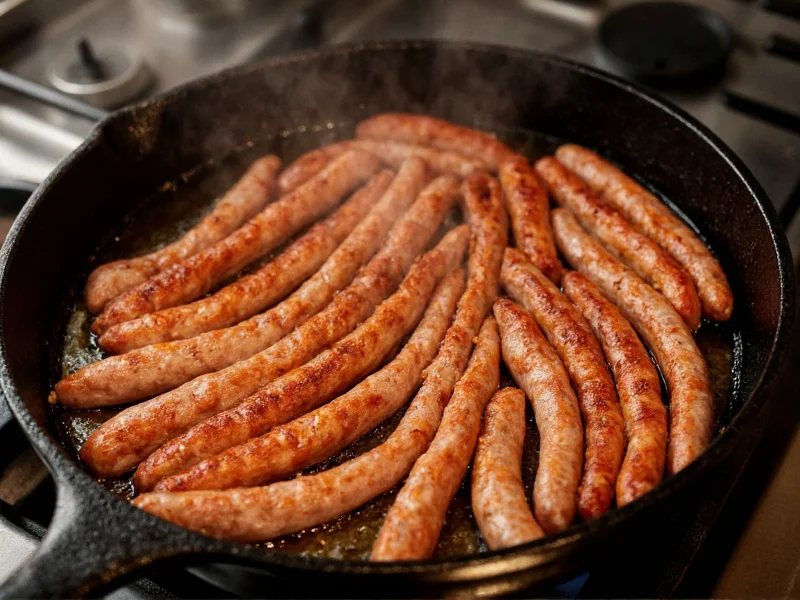Getting sausage temperature right isn't just about perfect texture—it's a critical food safety requirement. Undercooked sausage can harbor harmful bacteria like Salmonella, E. coli, and Trichinella that cause serious foodborne illnesses. The USDA Food Safety and Inspection Service mandates specific internal temperatures to eliminate these pathogens while preserving optimal flavor and juiciness.
Why Precise Sausage Temperature Matters
Sausage presents unique food safety challenges compared to whole cuts of meat. Because it's ground meat, any bacteria present on the surface gets distributed throughout the product during processing. This is why ground meats require higher internal temperatures than whole-muscle cuts like steaks.
Unlike visual cues like color or texture, which can be unreliable indicators of doneness, an accurate internal temperature reading provides the only definitive confirmation that your sausage has reached a safe cooking point. Relying solely on appearance often leads to either undercooked sausage (posing health risks) or overcooked sausage (resulting in dry, tough texture).
Sausage Temperature Guidelines by Type
Different sausage varieties require specific temperature targets based on their ingredients. Here's a comprehensive reference chart:
| Sausage Type | Safe Internal Temperature | Additional Notes |
|---|---|---|
| Pork sausage (including bratwurst) | 160°F (71°C) | Continue cooking 2-3 minutes after reaching temperature for optimal texture |
| Beef sausage | 160°F (71°C) | May appear slightly pink at proper temperature due to curing agents |
| Chicken or turkey sausage | 165°F (74°C) | Requires higher temperature than pork due to salmonella risk |
| Lamb sausage | 160°F (71°C) | Check multiple points as fat distribution affects cooking |
| Veggie sausage | 165°F (74°C) | Primarily for food safety of other ingredients in the mix |
Proper Thermometer Technique for Sausages
Using a thermometer correctly is as important as the temperature itself. Many home cooks make critical errors when checking sausage temperature:
- Insert in the right spot: Place the probe into the thickest part of the sausage, avoiding contact with the cooking surface or bone
- Check multiple sausages: Test at least two sausages per batch as cooking can be uneven
- Wait for stabilization: Leave the thermometer in place for 10-15 seconds until the reading stops changing
- Clean between uses: Sanitize the probe with hot, soapy water when checking different sausage types
Digital instant-read thermometers provide the most accurate sausage temperature readings. Dial thermometers often lack the precision needed for thin sausage links. For best results, calibrate your thermometer monthly using the ice water method (should read 32°F/0°C in ice water).
Cooking Methods and Temperature Management
Different cooking techniques require specific temperature management approaches:
Grilling Sausages
Use a two-zone fire with direct and indirect heat areas. Start sausages over indirect heat until they reach 140°F (60°C), then move to direct heat for browning. This prevents casing rupture while ensuring thorough cooking. Never pierce sausages to check doneness—this releases precious juices.
Pan-Frying Sausages
Cook over medium heat (325-350°F) to allow heat to penetrate without burning the exterior. Add 1/4 cup water when sausages reach 130°F (54°C) and cover to create steam that helps reach safe temperatures without drying out.
Baking Sausages
Preheat oven to 375°F (190°C). Place sausages on a wire rack over a baking sheet for even air circulation. Rotate halfway through cooking. Baking typically takes 20-25 minutes for standard links.
Visual Indicators Beyond Temperature
While temperature is definitive, these visual cues confirm proper cooking:
- Juices run clear, not pink
- Firm texture when gently pressed (not soft or mushy)
- Casing is browned and slightly crisp
- Meat appears cooked throughout with no raw spots
Remember that cured sausages like kielbasa may retain a pink color even when fully cooked due to nitrites in the curing process. Always verify with a thermometer rather than relying on color alone.
Common Temperature Mistakes to Avoid
Even experienced cooks make these critical errors:
- Testing too early: Checking temperature before sausages have had time to cook through gives false low readings
- Not resting: Remove sausages from heat when 5°F below target temperature; carryover cooking will raise it to safe level during 3-5 minute rest
- Surface-only reading: Inserting thermometer just under the surface rather than into the center
- Ignoring thermometer calibration: An uncalibrated thermometer can be off by 10°F or more
Storage and Reheating Guidelines
Properly cooked sausages should be refrigerated within two hours. Store in airtight containers for up to four days. When reheating, bring internal temperature back to 165°F (74°C) to ensure safety. Frozen cooked sausages maintain quality for 2-3 months.
Special Considerations for Different Sausage Styles
Traditional European sausages often follow different food safety standards than USDA guidelines. While German bratwurst might be traditionally served at 150°F (66°C) in Germany, the USDA recommends 160°F (71°C) for safety in the United States. When preparing international recipes, always follow your local food safety regulations.
Pre-cooked sausages like hot dogs only need to be reheated to 140°F (60°C), but many food safety experts recommend heating to 165°F (74°C) for vulnerable populations including young children, pregnant women, and immunocompromised individuals.
Can sausage be slightly pink and still be safe to eat?
Yes, sausage can appear slightly pink and still be safe if it has reached the proper internal temperature. Curing agents like sodium nitrite preserve pink color even when fully cooked. Always verify with a thermometer rather than relying on color alone.
How long should I let sausage rest after reaching proper temperature?
Let sausage rest for 3-5 minutes after removing from heat. During this time, the internal temperature will continue to rise 5°F due to carryover cooking, helping it reach the final safe temperature while allowing juices to redistribute for better texture.
What's the difference between cooking fresh sausage and pre-cooked sausage?
Fresh sausage must be cooked to 160°F (71°C) for pork/beef or 165°F (74°C) for poultry. Pre-cooked sausages like hot dogs only need reheating to 140°F (60°C), though 165°F is recommended for vulnerable populations. Always check package instructions for pre-cooked varieties.











 浙公网安备
33010002000092号
浙公网安备
33010002000092号 浙B2-20120091-4
浙B2-20120091-4